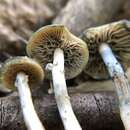en
names in breadcrumbs


Psilocybe ovoideocystidiata is a psilocybin mushroom, having psilocybin and/or psilocin as main active compounds. It is closely related to P. subaeruginascens from Java, P. septentrionalis from Japan, and P. wayanadensis from India. This mushroom was first documented by Richard V. Gaines in Montgomery County, Pennsylvania in June 2003. Although it is sometimes confused with Psilocybe caerulipes, it can be distinguished by its rhomboid spores, larger stature, earlier fruiting season and membranous annulus.
From the abundant ovoid pleurocystidia and cheilocystidia.
Psilocybe ovoideocystidiata is mainly native to the eastern United States, in a range that stretches from Kentucky to Rhode Island, but has been found as far south as Mississippi. It is particularly common in the Ohio river valley. Here, it is often found along rivers and streams, usually in the woody debris of overflow areas, in man-made mulch and wood chips, and is sometimes found alongside of Japanese knotweed. It also tends to prefer shady areas and avoid direct sunlight. More recently, it has turned up in the western United States, in the Pacific States from Western Washington to Southern California, though it is still a relatively uncommon species in this region. A relatively recently identified species, there is evidence that its range is currently undergoing rapid expansion, and it is frequently reported to appear in new areas.
This mushroom is typically gregarious, growing in groups of several hundred individuals in one particular area, as well as in multiple small clusters of several mushrooms each, within close proximity of one another. Solitary specimens also occur on occasion.
Seasonality varies a great deal depending on what region they are found in, but in the northeastern US, they are most common in the spring, from mid-April to late-June (peaking late-May), especially after periods of steady heavy rain for several consecutive days (a common weather pattern in the eastern US during spring). However, they may occasionally fruit as late as November. These mushrooms seem to be very sensitive to the season and fruit chiefly in the spring; very little fruiting occurs during other times of year, even during favorable weather condition. [2]
 Psilocybe ovoideocystidiata spores
Psilocybe ovoideocystidiata spores Psilocybe ovoideocystidiata is a psilocybin mushroom, having psilocybin and/or psilocin as main active compounds. It is closely related to P. subaeruginascens from Java, P. septentrionalis from Japan, and P. wayanadensis from India. This mushroom was first documented by Richard V. Gaines in Montgomery County, Pennsylvania in June 2003. Although it is sometimes confused with Psilocybe caerulipes, it can be distinguished by its rhomboid spores, larger stature, earlier fruiting season and membranous annulus.